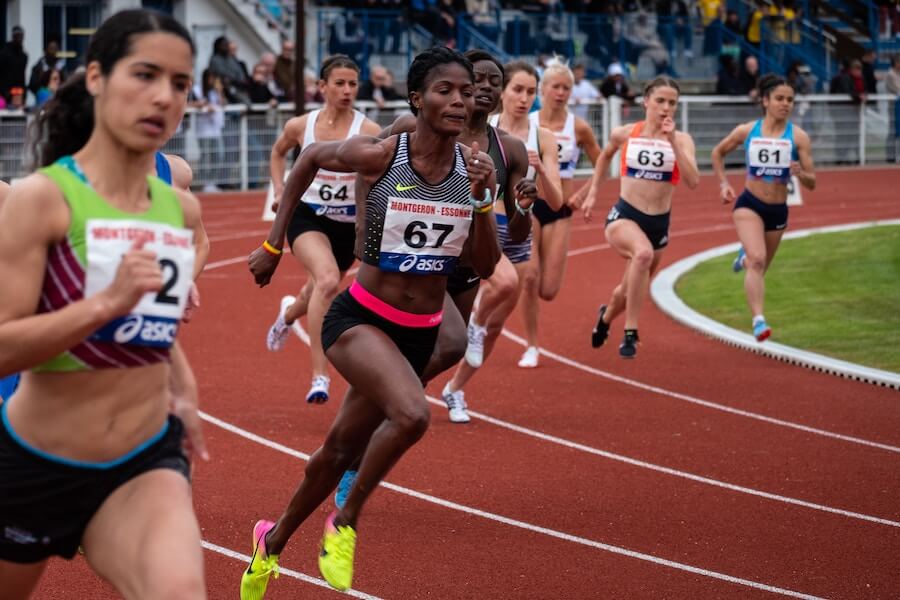Athletes prefer indoor and outdoor tracks for various reasons. While indoor tracks are becoming more common, outdoor tracks are still preferred. So how are indoor tracks converted to outdoor ones?

Converting indoor to outdoor tracks requires accurate measurements and meticulous planning. As a result, there are several key factors to consider.
Here, we discuss those factors and the time and calculations involved. This way, we give a well-rounded view of what an indoor-to-outdoor track conversion looks like.
Steps Involved in Indoor to Outdoor Track Conversion
While indoor tracks have their perks, such as protection against the elements, several reasons exist to convert an indoor track to an outdoor one. That said, here are the individual steps to take when converting an indoor to an outdoor track:
Evaluate Existing Track
The first step of indoor-to-outdoor track conversion is to examine the existing track and determine if any changes need to be made. This evaluation process often involves noting the track’s surface, shape, and size.
Also, it would be best if you accounted for your region’s climate. If the indoor track surface is of materials suitable for outdoor use, conversion becomes way more straightforward.
You should patch damaged areas and install a proper drainage system for the tracks. Outdoors often require extra safety features such as padding and fencing too.
Calculations
Before kicking off the conversion process, measuring the distance of the indoor track is crucial. To achieve this, we put together the length and how many laps it will take to reach a mile.
Most indoor tracks are 200 meters and would take eight laps to get a mile. Hence, the distance is about 1,600 meters. Once we have the distance of the indoor track on lock, we can start the conversion.
Here are the steps involved in making the outdoor track:
1. Decide on the size of the Outdoor Track
The first step is to decide on the size of the outdoor track. Most outdoor tracks are between 400 meters or more. Hence, you would have to double the length of the indoor track to make the outdoor track.
2. Mark the Track Out
Once you have selected the desired track size, you need to mark it out. To do this, you can either use paint or chalk. Afterward, you must outline the starting line, finish line, and lanes.
3. Install the necessary equipment
With outdoor tracks, you need to install specific pieces of equipment. For instance, there is a need for hurdles, starting blocks, and throwing circles. There is also a need for a timing system.
5. Adjust the Distance
After installing the equipment, you must adjust the track’s distance to match the outdoor length. If you want to create a 400-meter outdoor track, it works similarly to an indoor track. However, if it is a smaller track, a different rule applies. As a result, getting professional help from start to finish is integral.
Extras:
While planning a conversion, you need to measure the length and width of the track to ensure it’s in line with the set standards. For instance, outdoor tracks must be 400 meters or more, while indoor tracks can be shorter.
Another imperative aspect of these calculations includes banking (or the angle of the curves on the track.) This is crucial as it ensures athletes maintain speed and avoid injury while running past the curves. The ideal angle of the curves for an outdoor track is between 10 to 20 degrees.
How Long Does It Convert An Indoor to Outdoor Track Take?
The time it takes for indoor to outdoor conversion varies. Track conversion is a time-consuming project that can take months and depends on the size and complexity of the track.
However, other factors, such as weather conditions and permits, can impede the speed of the construction team.
Track conversion is a critical project. Hence, you must work with experienced teams to complete it promptly and effectively. Also, there is a need to account for the availability of funds.

Factors to Consider During Indoor-to-Outdoor Track Conversion
While conversion to outdoor tracks can be very beneficial, there are factors to consider when transitioning. Here are some factors to consider:
- Financial consideration
- Required maintenance
Financial Consideration
The cost is a crucial factor when deciding to convert to outdoor tracks. Converting to outdoor tracks is costly and can reach high numbers. However, it has several long-term benefits.
Converting an indoor track into an outdoor track is a terrific investment with a high ROI possibility. It offers athletes in these communities opportunities to compete and train in new environments. Also, the tracks can serve as a way to generate revenue for those who own it.
Required Maintenance
Outdoor tracks are more exposed to the element and vulnerable to wear and tear. As a result, they need constant maintenance to keep them in good condition.
Regular maintenance involves cleaning, repairing, and resurfacing damages caused by heavy use and elements. How often the tracks are maintained depends on the material used, frequency of use and climate.
Calculating Time on an Indoor versus Outdoor Track
Many athletes and trainers believe the running times on outdoor and indoor tracks are the same. But that’s in no way true.
There is a disparity between the time it takes athletes to run on both tracks. Athletes must note this when they train or compete.
Indoor tracks and outdoor tracks have different lengths. The length of indoor tracks is about 200 meters, while outdoor tracks are 400 meters or more.
As a result, an indoor track athlete needs to run more laps to reach the same distance as on an outdoor track.
Athletes can use the conversion factor to calculate the time difference between races on indoor and outdoor tracks. This factor depends on the differences between an indoor and outdoor track.
For instance, an athlete running 800 meters on an indoor track must go through 4 laps. While on an outdoor track, they must go through 2 laps.
If the athlete takes 3 minutes to run the indoor track, the outdoor track will take about 3 and 6 seconds. This is due to the conversion factor of 1.02 for 800 meters.
The conversion factor varies with distance. Here is a table that shows the table for various distances and their conversion factors:
| Distance | Conversion Factor |
| 800m | 1.02 |
| 1500m | 1.04 |
| Mile (1600m) | 1.06 |
| 3000m | 1.08 |
| 5000m | 1.10 |
| 10,000m | 1.12 |
With a conversion factor, athletes have a well-rounded idea of their speed. They can deduce their time on an outdoor track using their performance on an indoor track.

Takeaway
There are several perks to Indoor-to-outdoor conversion. It benefits coaches, athletes, and even the facilities that use it.
Outdoor tracks allow for more variety in competitions and training. However, it is crucial to consider factors such as maintenance, cost, and weather when deciding.
Regarding calculating times on indoor and outdoor tracks, athletes and trainers can use conversion factors. The conversion factor helps to estimate athletes’ performance.
Awareness of the conversion factor helps athletes better prepare for races and training sessions.

When I was in high school, I was the best at running. Running for me is not a trend, this is my whole life. I jog every morning, without exceptions: I don’t skip mornings on vacations or business trips. My friends are also sports fans: I went to my best friend’s yoga class for the first time about three years ago.
Since then, I’ve been practicing regularly, and we have also made several yoga trips to India. For my last birthday, I got a skateboard as a present from her. Now we’re both taking personal classes with a coach, and it’s 100% fun!





